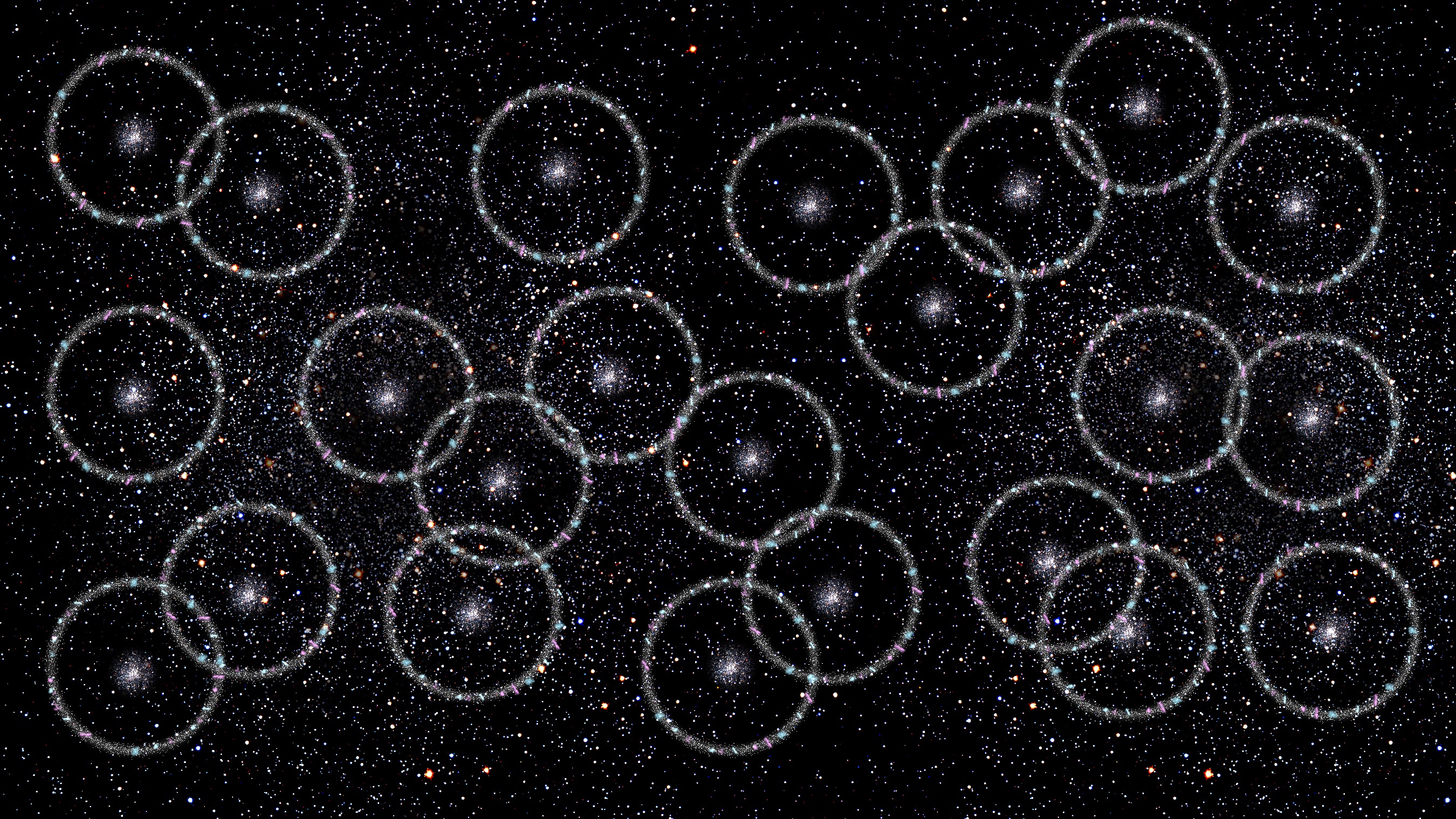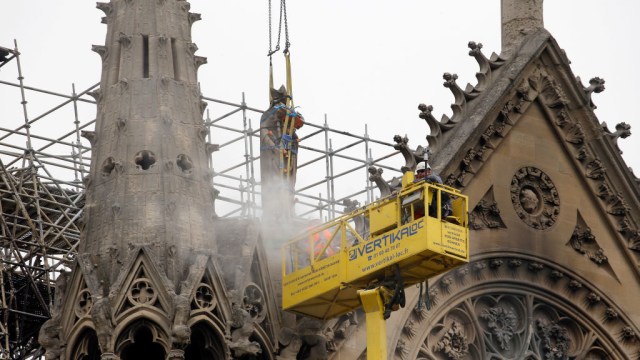Ask Ethan: How Can A Black Hole’s Singularity Spin?
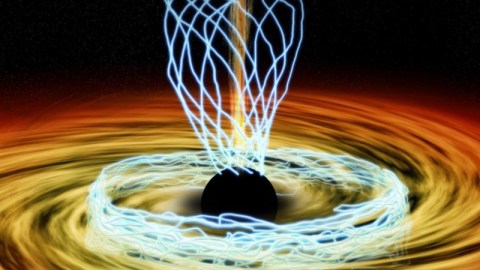
If a star spins and then collapses, what happens to its angular momentum?
The most common way to form a black hole in the Universe is to have a massive star reach the end of its life and explode in a catastrophic supernova. However, while the outside portions of the star are blown apart, the inner core collapses, forming a black hole if the progenitor star is massive enough. But most real stars, including our Sun, are spinning. Therefore — since angular momentum is always conserved — they shouldn’t be able to collapse down to a single point. How does this all work? That’s what our Patreon supporter Aaron Weiss wants to know, asking:
How [is] angular momentum conserved when stars collapse to black holes? What [does] it means for a black hole to spin? What is actually spinning? How can a singularity spin? Is there a “speed limit” to this spin rate and how does the spin affect the size of the event horizon and the area immediately around it?
These are all good questions. Let’s find out.
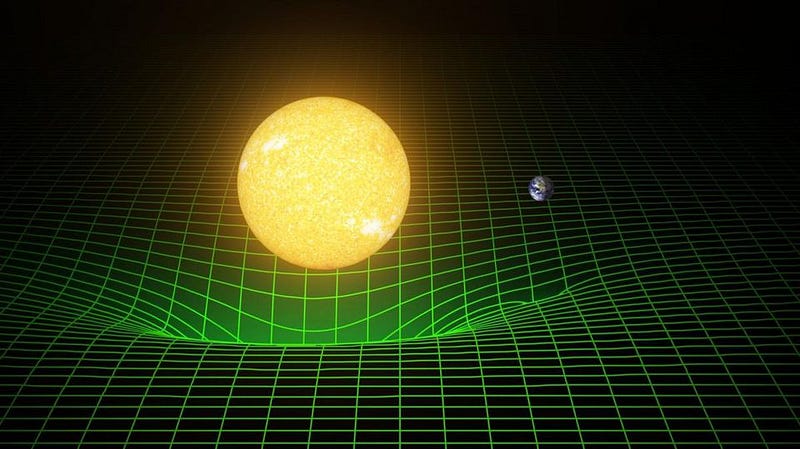
When Einstein first put forth his theory of gravity, General Relativity, he forged an inseparable link between spacetime, which represents the fabric of our Universe, and all the matter and energy present within it. What we perceived as gravity was simply the curvature of space, and the way that matter and energy responded to that curvature as they moved through spacetime. Matter and energy tell spacetime how to curve, and that curved space tells matter and energy how to move.
Almost immediately, Einstein recognized that this picture came along with a bizarre consequence that was difficult to reconcile with the Universe we have: a matter-filled Universe was unstable. If you had, on average, space that was filled with a uniform amount of stationary matter — no matter the shape, size, or amount — it would inevitably collapse to form a perfectly spherical black hole.
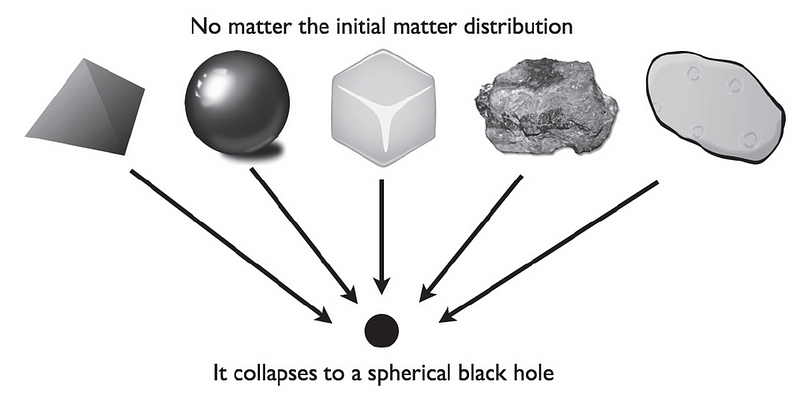
Once you get matter with a sufficient amount of mass confined to a small enough volume, an event horizon will form at a particular location. A spherical region of space, whose radius is defined by the quantity of mass inside of it, will experience such severe curvature that anything passing interior to its boundary will be unable to escape.
Outside of this event horizon, it will appear as though there is just an extreme region where gravity is very intense, but no light or matter can be emitted from within it. To anything that falls inside, however, it inevitably gets brought towards the very center of this black hole: towards a singularity. While the laws of physics break down at this point — some physicists cheekily refer to singularities as places where “God divided by zero” — no one doubts that all the matter and radiation that passes inside the event horizon heads towards this point-like region of space.

I can hear the objections already. After all, there are a legitimate number of ways the actual Universe works differently from this naive picture of gravitational collapse.
- The gravitational force isn’t the only one in the Universe: nuclear forces and electromagnetism play a role when it comes to matter and energy, too.
- Black holes aren’t formed from the collapse of a uniform distribution of matter, but rather by the implosion of a massive star’s core when nuclear fusion can no longer continue.
- And, perhaps most importantly, all stars we’ve ever discovered spin, and angular momentum is always conserved, so black holes should be spinning, too.
So let’s do it: let’s go from the realm of a simplistic approximation to a more realistic picture of how black holes truly work.
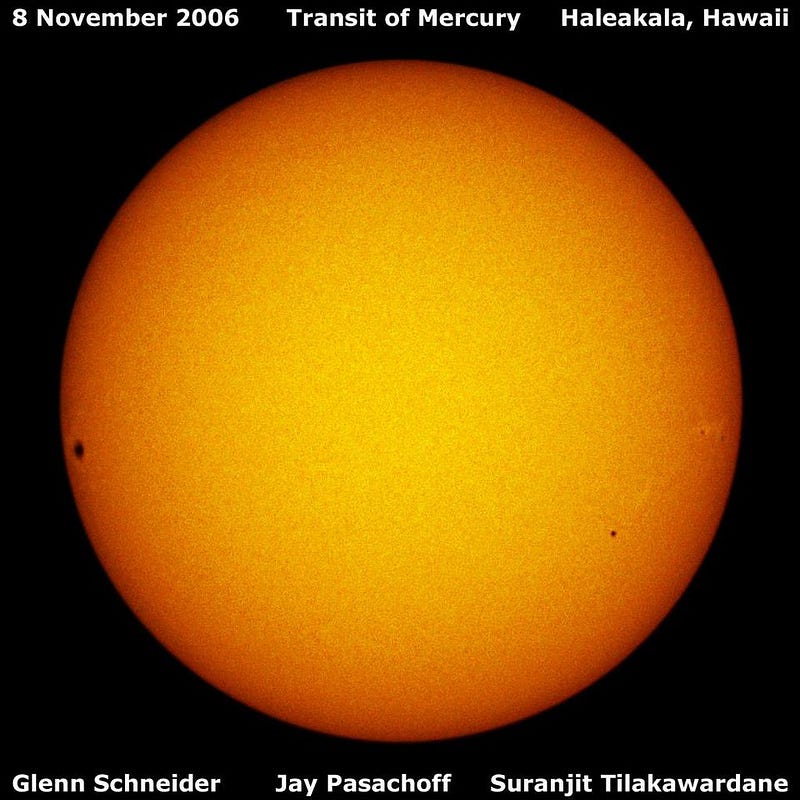
All stars spin. Our Sun, a relatively slow rotator, completes a full 360° turn on timescales ranging from 25 to 33 days, depending on which particular solar latitude you’re monitoring. But our Sun is huge and very low-density, and there are far more extreme objects in the Universe in terms of small physical sizes and large masses. Just as a spinning figure skater speeds up when they bring their arms and legs in, astrophysical masses rotate more quickly if you decrease their radius.
If the Sun were a white dwarf — with the same mass but the physical size of Earth — it would rotate once every 4 minutes.
If it became a neutron star — with the same mass but a radius of 20 km — it would rotate once every 2.4 milliseconds: consistent with what we observe for the fastest pulsars.
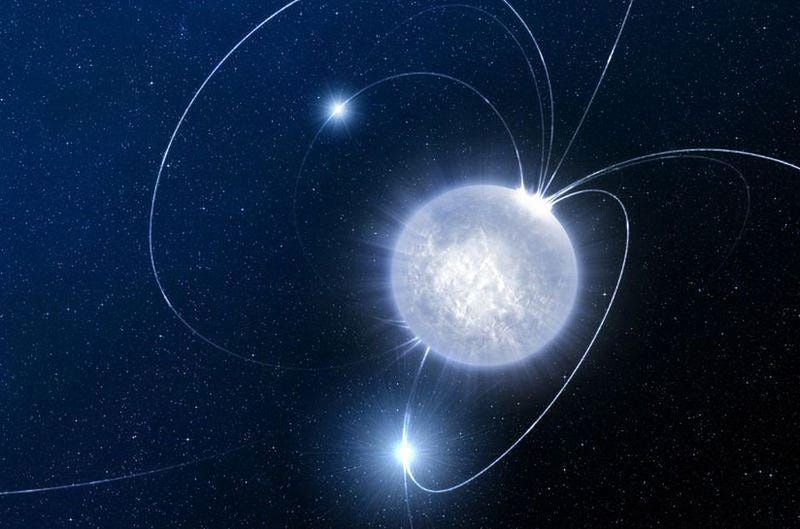
Well, if our star (or any star) collapsed down to a black hole, we’d still have to conserve angular momentum. When something spins in this Universe, there’s no way to just get rid of it, the same way you can’t create or destroy energy or momentum. It has to go somewhere. When any collection of matter collapses down to a radius smaller than the radius of an event horizon, that angular momentum is trapped inside there, too.
This is okay! Einstein put forth his theory of General Relativity in 1915, and it was only a few months later that Karl Schwarzschild found the first exact solution: for a point mass, the same as a spherical black hole. The next step in modeling this problem in a more realistic fashion — to consider what if the black hole also has angular momentum, instead of mass alone — wasn’t solved until Roy Kerr found the exact solution in 1963.
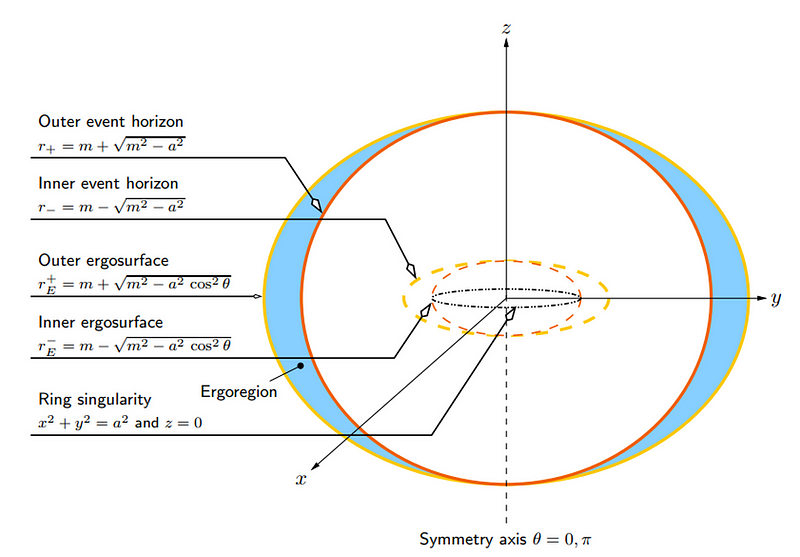
There are some fundamental and important differences between the more naive, simpler Schwarzschild solution and the more realistic, complex Kerr solution. In no particular order, here are some fascinating contrasts:
- Instead of a single solution for where the event horizon is, a rotating black hole has two mathematical solutions: an inner and and outer event horizon.
- Outside of even the outer event horizon, there is a place known as the ergosphere, where space itself is dragged around at a rotational speed equal to the speed of light, and particles falling in there experience enormous accelerations.
- There is a maximum ratio of angular momentum to mass that is allowed; if there is too much angular momentum, the black hole will radiate that energy away (via gravitational radiation) until it’s below that limit.
- And, perhaps most fascinatingly, the singularity at the black hole’s center is no longer a point, but rather a 1-dimensional ring, where the radius of the ring is determined by the mass and angular momentum of the black hole.
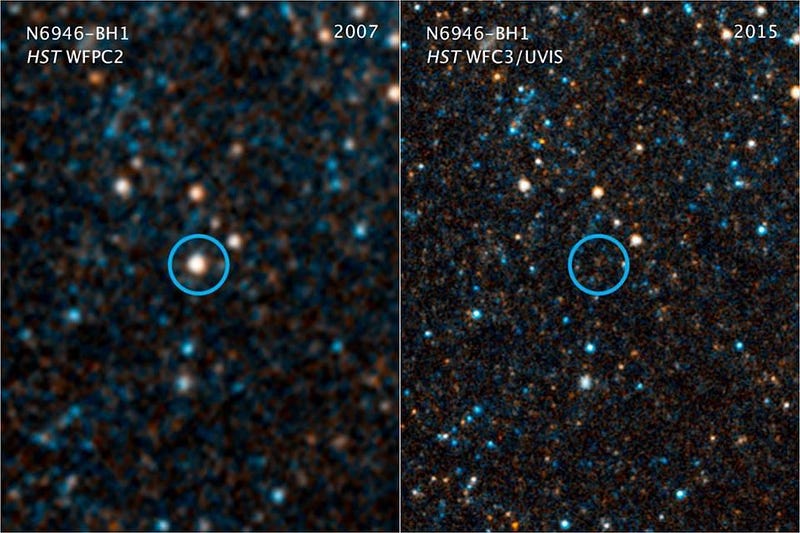
All of this is true for a rotating black hole from the instant you create the event horizon for the first time. A high-mass star can go supernova, where the spinning core implodes and collapses down to a black hole, and all of this will be true. In fact, there is even some hope that if a supernova goes off in our own local group, LIGO might be able to detect the gravitational waves from a rapidly rotating black hole’s ringdown.
If you form a black hole from a neutron star-neutron star merger or the direct collapse of a star or gas cloud, the same possibilities hold true. But once your black hole exists, its angular momentum can constantly change as new matter or material falls in. The size of the event horizon can grow, and the size of the singularity and ergosphere can grow orshrink depending on the angular momentum of the new material that gets added.

This leads to some fascinating behavior that you might not expect. In the case of a non-rotating black hole, a particle of matter outside of it can orbit, escape, or fall inside, but will remain in the same plane. When a black hole rotates, however, it gets dragged around through all three dimensions, where it will fill a torus-like region surrounding the black hole’s equator.
There’s also an important distinction between a mathematical solution and a physical solution. If I told you I had the (square root of 4) oranges, you would conclude that I had 2 oranges. You could have just as easily concluded, mathematically, that I had -2 oranges, because the square root of 4 could just as easily be -2 as it could be +2. But in physics, there’s only one meaningful solution. As scientists have long noted, though:
…you should not physically trust in the inner horizon or the inner ergosurface. Although they are certainly there as mathematical solutions of the exact vacuum Einstein equations, there are good physics reasons to suspect that the region at and inside the inner horizon, which can be shown to be a Cauchy horizon, is grossly unstable — even classically — and unlikely to form in any real astrophysical collapse.
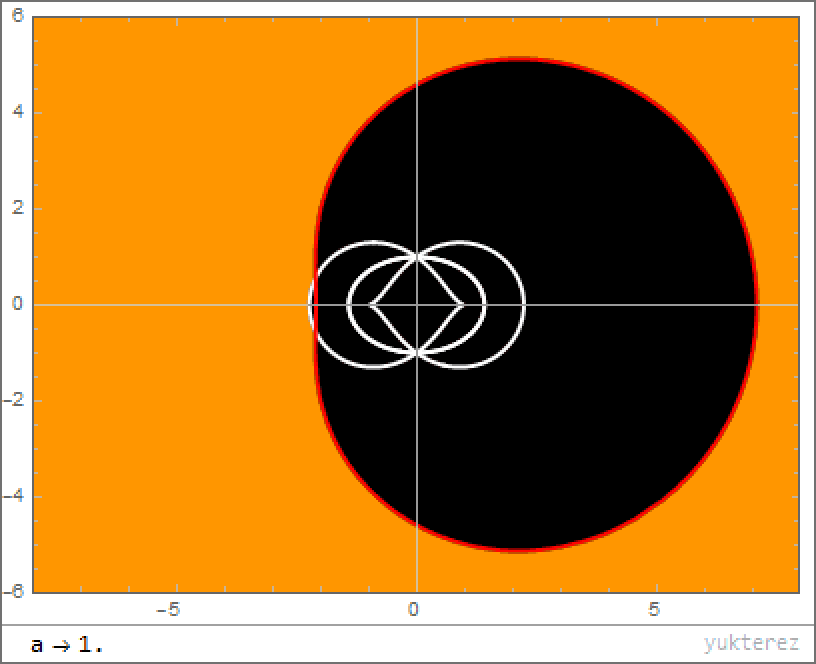
Now that we’ve finally observed a black hole’s event horizon for the first time, owing to the incredible success of the Event Horizon Telescope, scientists have been able to compare their observations with theoretical predictions. By running a variety of simulations detailing what the signals of black holes with various masses, spins, orientations, and accreting matter flows would be, they’ve been able to come up with the best fit for what they saw. Although there are some substantial uncertainties, the black hole at the center of M87 appears to be:
- rotating at 94% of its maximum speed,
- with a 1-dimensional ring singularity with a diameter of ~118 AU (larger than Pluto’s orbit),
- with its rotational axis pointing away from Earth at ~17°,
- and that all of the observations are consistent with a Kerr (which is favored over a Schwarzschild) black hole.
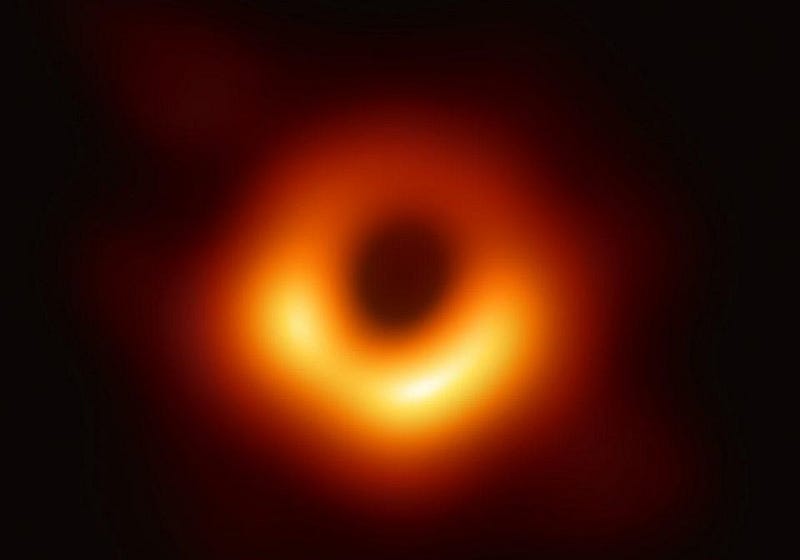
Perhaps the most profound takeaway from all of this, though, is that in a rotating spacetime, space itself can indeed move without any sort of speed limit at all. It’s only the motion of matter and energy through space that’s limited by the speed of light; space itself has no such speed limit. In the case of a rotating black hole, there is a region of space beyond the event horizon where space is dragged around the black hole at a speed faster than the speed of light, and this is just fine. Matter still cannot move through that space at speeds exceeding the ultimate cosmic speed limit, and all of this is consistent with both relativity and what we observe.
As more black holes are imaged and more and improved observations come in, we fully expect to learn even more about the physics of real, spinning black holes. But until then, know that our theory and observation are guiding us in a direction that’s tremendously profound, self-consistent, and — above all — the best approximation of reality that we currently have.
Send in your Ask Ethan questions to startswithabang at gmail dot com!
Ethan Siegel is the author of Beyond the Galaxy and Treknology. You can pre-order his third book, currently in development: the Encyclopaedia Cosmologica.

